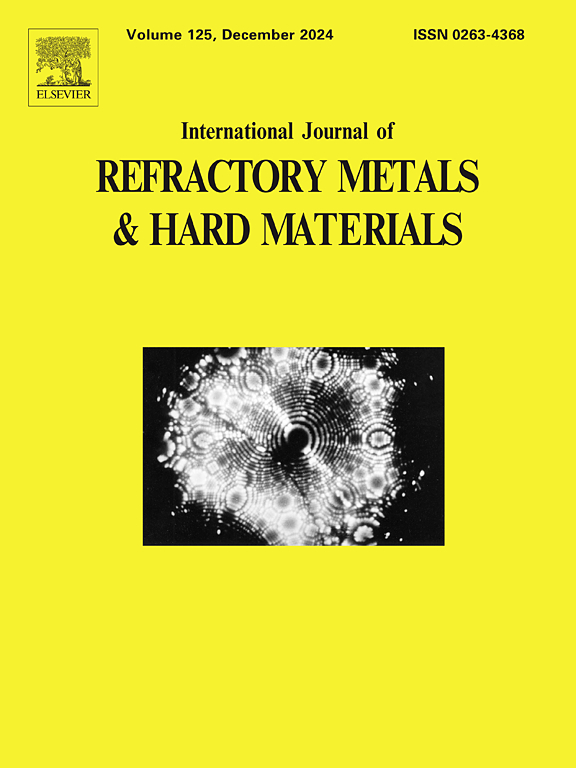热处理对冷喷钛金刚石复合涂层耐磨性的影响
IF 4.2
2区 材料科学
Q2 MATERIALS SCIENCE, MULTIDISCIPLINARY
International Journal of Refractory Metals & Hard Materials
Pub Date : 2024-10-19
DOI:10.1016/j.ijrmhm.2024.106924
引用次数: 0
摘要
为了提高冷喷涂钛涂层的耐磨性,制作了钛-金刚石(Ti-MD)复合涂层,然后在不同温度下进行热处理。采用 X 射线衍射 (XRD)、扫描电子显微镜 (SEM)、透射电子显微镜 (TEM)、显微硬度测试和耐磨性实验评估了热处理温度对复合涂层耐磨性的影响。结果表明,复合涂层在热处理后没有发生相变,并表现出更高的显微硬度和更好的耐磨性。孔隙率结果表明,涂层的孔隙率随着热处理温度的升高而降低。TEM 结果表明,在 800 °C 热处理后,钛和金刚石颗粒之间的界面上形成了稳定的 TiC(约 10 nm),纳米压痕结果表明,热处理后的涂层具有更高的抗变形能力。具体而言,当热处理温度升至 800 ℃ 时,复合涂层的磨损率降低了 80%,这主要归功于涂层孔隙率的降低以及钛和金刚石颗粒之间附着力的增强。热处理涂层的磨损机制主要是减少氧化磨损和磨料磨损。本文章由计算机程序翻译,如有差异,请以英文原文为准。
Effect of heat treatment on wear resistance of cold-sprayed Ti-diamond composite coating
In order to enhance the wear resistance of cold-sprayed Ti coatings, Ti-diamond (Ti-MD) composite coatings were fabricated, followed by heat treatment at different temperatures. The effects of heat treatment temperature on the wear resistance of the composite coatings were assessed using X-ray diffraction (XRD), scanning electron microscopy (SEM), transmission electron microscopy (TEM), microhardness testing, and wear resistance experiments. The results show that the composite coating undergo no phase transformation after heat treatment, and exhibits higher microhardness and improved wear resistance. The porosity results showed that the porosity of the coating decreased as the heat treatment temperature increases. TEM results showed that stable TiC (about 10 nm) was formed at the interface between the titanium and diamond particles after heat treatment at 800 °C, and nanoindentation results showed that the heat-treated coating had higher deformation resistance. Specifically, when the heat-treated temperature rose to 800 °C, the composite coating exhibits an 80 % reduction in wear rate, primarily attributable to the decreased porosity of the coating and the enhanced adhesion between Ti and diamond particles. The wear mechanisms of the heat-treated coatings are predominantly reduced oxidative and abrasive wear.
求助全文
通过发布文献求助,成功后即可免费获取论文全文。
去求助
来源期刊
CiteScore
7.00
自引率
13.90%
发文量
236
审稿时长
35 days
期刊介绍:
The International Journal of Refractory Metals and Hard Materials (IJRMHM) publishes original research articles concerned with all aspects of refractory metals and hard materials. Refractory metals are defined as metals with melting points higher than 1800 °C. These are tungsten, molybdenum, chromium, tantalum, niobium, hafnium, and rhenium, as well as many compounds and alloys based thereupon. Hard materials that are included in the scope of this journal are defined as materials with hardness values higher than 1000 kg/mm2, primarily intended for applications as manufacturing tools or wear resistant components in mechanical systems. Thus they encompass carbides, nitrides and borides of metals, and related compounds. A special focus of this journal is put on the family of hardmetals, which is also known as cemented tungsten carbide, and cermets which are based on titanium carbide and carbonitrides with or without a metal binder. Ceramics and superhard materials including diamond and cubic boron nitride may also be accepted provided the subject material is presented as hard materials as defined above.

 求助内容:
求助内容: 应助结果提醒方式:
应助结果提醒方式:


